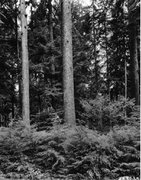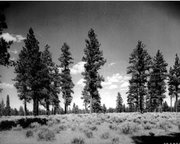Cascade Mixed Forest - Coniferous Forest - Alpine Meadow Province
Contents
Cascade Mixed Forest - Coniferous Forest - Alpine Meadow Province (Bailey)
Pacific Northwest, 53,400 mi2 (138,300 km2)
Land-surface form
The Cascade Province covers a series of steep, rugged mountains bordered in places by a narrow coastal plain. Mountains along the coast rise 5,000 ft (1,500 m) above sea level, with a local relief of 1,000-3,000 ft (300-900 m). The interior Cascade Range has mountains 8,000-9,000 ft (2,400-2,700 m) in altitude, dominated every 5-85 mi (8-135 km) by a volcano of much higher elevation. Mt. Rainier, for example, rises more than 14,000 ft (4,300 m) above sea level. Some parts of the province, especially its northern portion and the Cascade Range, have been glaciated.
Climate
Because this province borders on the Pacific Ocean, its climate is characterized by generally mild temperatures averaging 35 to 50F (2 to 10C) throughout the year. Rainfall is heavy, 30 to 150 in (770 to 3,800 mm) per year, with a maximum in winter. Humidity is always high, producing an extremely favorable precipitation/evaporation ratio. The southern part of this province is winter-wet with no snow; fog partially compensates for the summer drought. As one moves to the north, the summer dry season shortens, and the proportion of precipitation falling as snow increases. On high mountains, all precipitation may be snow, which reaches depths of 50 to 65 ft (15 to 20 m). East slopes are much drier than west slopes, accumulating less than 20 in (511 mm) of precipitation per year.
Vegetation
The Cascade Province is primarily montane, but it ranges from sea level to altitudes above 5,000 ft (1,500 m). At the lowest elevations, there is a dense conifer forest of Douglas-fir, western red cedar, western hemlock, grand fir, silver fir, Sitka spruce, and Alaska-cedar. Numerous species of shrubs grow exceptionally well in this forest and around its margins. In many places, this vegetation is practically impenetrable.
Although Douglas-fir is the most abundant tree at lower elevations in the region, it is not part of the climax forest. Western hemlock and several other species of fir are more tolerant of shade than Douglas-fir, and in mature forest stands, Douglas-fir cannot regenerate. On the western and southern slopes of the Olympic Mountains in Washington, hemlock is eventually displaced by the more shade-tolerant silver fir.
In the humid conifer forests of southwestern Oregon, Alaska-cedar is replaced by silver fir and redwood. In the fog belt along the coast of northwestern California, redwood is the characteristic tree. Douglas-fir and other conifers associate with it to form perhaps the densest of all coniferous forests, with the world's largest trees. Some redwoods attain heights of more than 325 ft (99 m) and girths of more than 65 ft (19.8 m).
A xerophytic forest of ponderosa pine grows along the dry eastern slopes of the Cascades, descending to 500 ft (150 m) along the eastern foot of the range at the Columbia River. This is typically open forest mixed with grass and shrubs. It occurs throughout the Southwest, the Sierra Nevada, the Rocky Mountains, and the Black Hills.
The high, snowcapped mountains of the Cascades have a well-marked subalpine forest belt that reaches into British Columbia. Important trees are mountain hemlock, subalpine fir, whitebark pine, and Alaska-cedar. To the north, the subalpine forest becomes fragmentary or disappears completely.
All but the highest peaks are covered by forest. In the Cascade Mountains of Oregon, timberline varies from 7,700 to 10,000 ft (2,350 to 3,050 m). Above timberline, there is an alpine zone with rich communities of shrubs and herbs. Perpetual snow is confined to small patches.
Riparian forests in the Pacific Northwest are an exception to the general rule that conifers dominate in the region. Along the region's many rivers and streams, needleleaf trees are replaced by broadleaf species such as black cottonwood and red alder. This kind of forest occurs from southern Alaska south through Washington, Oregon, Idaho, and western Montana, continuing into northern California and the Sierra Nevada.
Soils
Andisols are extensive where underlain by volcanic ash. Moist Inceptisols are found west of the Cascades; dry soils predominate in the rain shadow east of the mountains.
Fauna
Common large mammals include elk, deer, mountain lion, bobcat, and black bear. Small mammals include mice, Douglas squirrels, martens, Townsend chipmunks, red tree voles, and bushytail wood rats.
The more common birds are the winter wren, Townsend's warbler, chestnut-backed chickadee, red-breasted nuthatch, gray jay, and Steller's jay. The most important game birds are blue and ruffed grouse; there are hawks and owls in the northwestern part of the province. Spotted owl and marbled murrelet depend on remaining old-growth forests.
Among the many species of amphibians that live in this region's moist, cool forests are the Pacific treefrog and the Pacific giant salamander. Reptiles include the northern alligator lizard and rubber boa.
The many swift-flowing rivers of the region are high in dissolved oxygen and generally unpolluted, making them ideal habitats for various salmon and trout species.
Return to Ecoregions of the United States
| Disclaimer: This article is taken wholly from, or contains information that was originally published by, the United States Forest Service. Topic editors and authors for the Encyclopedia of Earth may have edited its content or added new information. The use of information from the United States Forest Service should not be construed as support for or endorsement by that organization for any new information added by EoE personnel, or for any editing of the original content. |

